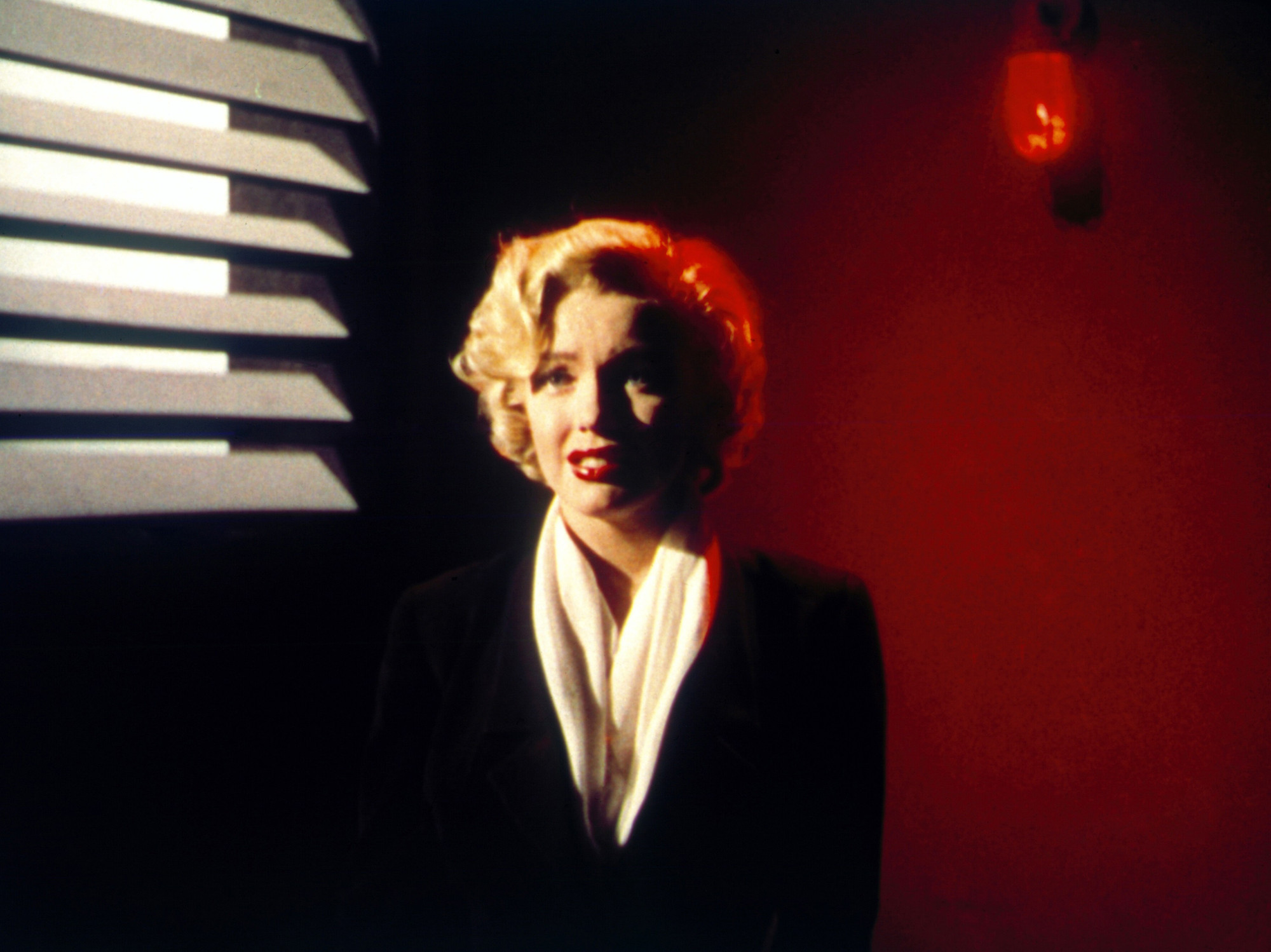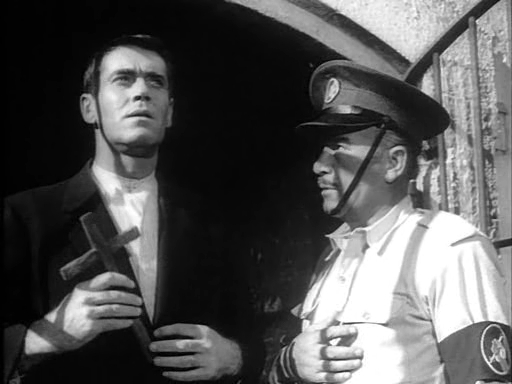spiderwort
Junior Member
  
@spiderwort
Posts: 2,101
Likes: 9,421
|
Post by spiderwort on May 3, 2018 16:34:41 GMT
Noir lighting is my favorite, just because I think it's so beautiful - and also because I like the "poetic" abstraction it often creates. This kind of lighting can be found in many films, not just those designated as "noirs" - any that use shadows and darkness to sculpt the light. One of my favorites of what I call "late noirs", but actually maybe it's "neo", I don't know, is Henry Hathaway's Niagara (1953), with Joseph Cotten and Marilyn Monroe. I don't think the story itself is that good, but I'm constantly amazed at what they did with the color lighting in that film, at a time when almost all color films were flat and over-lit. There are shadows in Niagara that are artistically sculpted by deep blacks with strong diagonal lines, especially in the bell tower sequence.    When it comes to black-and-white noirs, one of my favorites for its lighting is Murder, My Sweet (1944).   And here's a favorite from a non-noir that looks like a noir:
Citizen Kane (1941)  There are legions of other examples, of course. But I'll leave those for others to suggest. |
|
|
|
Post by mattgarth on May 3, 2018 16:48:21 GMT
|
|
|
|
Post by bravomailer on May 3, 2018 16:53:07 GMT
The Third Man has many such shots. My favorite is the desperate hands protruding from a grate. The hands, incidentally, are those of Carol Reed.  |
|
|
|
Post by Doghouse6 on May 3, 2018 20:00:07 GMT
|
|
|
|
Post by mikef6 on May 3, 2018 20:53:33 GMT
Louis Hayward in Fritz Lang’s “The House By The River” (1950). Cinematography by Edward Cronjager  Edmund O’Brien at the Bradbury Building in Rudolph Maté’s “D.O.A.” (1950). Cinematography by Ernest Laszlo  |
|
|
|
Post by kijii on May 3, 2018 21:29:19 GMT
The Fugitive (1947) / John Ford Though not considered a noir film, there is something happening here..what it is is not exactly clear..... I have never seen a 2-dimensional film constructed in such a way as to make me think that I am watching it in 3-D. There is a foreground and a background almost everywhere in this movie; there is a nearness and a farness ... This movie projects perspective in almost every sense of the word: 1. a technique of depicting volumes and spatial relationships on a flat surface. Compare aerial perspective, linear perspective. 2. a picture employing this technique, especially one in which it is prominent: an architect's perspective of a house. 3. a visible scene, especially one extending to a distance; vista: a perspective on the main axis of an estate. 4. the state of existing in space before the eye: The elevations look all right, but the building's composition is a failure in perspective. 5. the state of one's ideas, the facts known to one, etc., in having a meaningful interrelationship: You have to live here a few years to see local conditions in perspective. 6. the faculty of seeing all the relevant data in a meaningful relationship: Your data is admirably detailed but it lacks perspective. 7. a mental view or prospect: the dismal perspective of terminally ill patients.    _018.jpg) _018.jpg)   
|
|
|
|
Post by manfromplanetx on May 4, 2018 21:15:53 GMT
L'étrange Monsieur Victor (1938) Jean Grémillon . Cinematographer Werner Krien

|
|
|
|
Post by london777 on May 4, 2018 22:00:29 GMT
Is "Film Noir lighting" just Expressionist lighting done on the cheap? If not, what did Film Noir lighting add to, or alter in, the Expressionist tradition?
I am thinking about early Bergman films and also early David Lean and Carol Reed films. They use lots of dark shadows in ominous situations, but I would not call them Film Noir. Maybe the difference is that Film Noir lighting has sharper contrasts? If so, is that budget related?
|
|
|
|
Post by koskiewicz on May 4, 2018 22:18:08 GMT
"Touch of Evil"...incredible noir cinematography...
|
|
|
|
Post by Doghouse6 on May 4, 2018 22:41:09 GMT
Is "Film Noir lighting" just Expressionist lighting done on the cheap? If not, what did Film Noir lighting add to, or alter in, the Expressionist tradition? I am thinking about early Bergman films and also early David Lean and Carol Reed films. They use lots of dark shadows in ominous situations, but I would not call them Film Noir. Maybe the difference is that Film Noir lighting has sharper contrasts? If so, is that budget related? Those are good questions (and probably ones about which there can be much debate). My impressions are these: I tend to consider noir to be more minimalist, and with a less stylized and harder-edged effect; I think of Expressionist imagery as invoking imagination, and noir as hyper-realistic (which is its own kind of stylization). The two do have much in common, and noir cinematographers certainly exhibited Expressionist influences. Beyond that, I do feel that anything defined as film noir encompasses thematic as well as visual aspects. |
|
|
|
Post by petrolino on May 5, 2018 1:33:19 GMT
Is "Film Noir lighting" just Expressionist lighting done on the cheap? If not, what did Film Noir lighting add to, or alter in, the Expressionist tradition? I am thinking about early Bergman films and also early David Lean and Carol Reed films. They use lots of dark shadows in ominous situations, but I would not call them Film Noir. Maybe the difference is that Film Noir lighting has sharper contrasts? If so, is that budget related? Those are good questions (and probably ones about which there can be much debate). My impressions are these: I tend to consider noir to be more minimalist, and with a less stylized and harder-edged effect; I think of Expressionist imagery as invoking imagination, and noir as hyper-realistic (which is its own kind of stylization). The two do have much in common, and noir cinematographers certainly exhibited Expressionist influences. Beyond that, I do feel that anything defined as film noir encompasses thematic as well as visual aspects. They also absorbed photographic ideas from other "movements", "poetic realism" being a notable example, so it was probably "expressionism" +. |
|
|
|
Post by jervistetch on May 5, 2018 2:22:01 GMT
While not credited as a true Noir, Hitchcock's SUSPICION has one of my favorite examples of this creative style of lighting, courtesy of brilliant Cinematographer Harry Stradling, Sr.  |
|
spiderwort
Junior Member
  
@spiderwort
Posts: 2,101
Likes: 9,421
|
Post by spiderwort on May 5, 2018 18:45:48 GMT
Is "Film Noir lighting" just Expressionist lighting done on the cheap? If not, what did Film Noir lighting add to, or alter in, the Expressionist tradition? I am thinking about early Bergman films and also early David Lean and Carol Reed films. They use lots of dark shadows in ominous situations, but I would not call them Film Noir. Maybe the difference is that Film Noir lighting has sharper contrasts? If so, is that budget related? Great questions, London, which scholars have studied and written about for decades. I tend to agree with the comments that Doghouse6 and petrolino made. I think Noir was more or less born out Expressionism, then made less stylized or surreal with more concentration on deep blacks and strong but not distorted lines. It's hard to watch films that were made in the expressionistic, poetic realism, or even surrealist styles, and not see some correlations between all of them. But I think historical precedence probably belongs to Expressionism (though I could be wrong). And in terms of Noir, like doghouse said, generally speaking it also encompasses certain thematic elements (at least in terms of genre). Personally, I tend to think of it more in terms of style, but I'm probably in the minority in that. I pretty much take the French definition of it literally: "Black film." Oh, and as to your interesting question about its relation to budget, I can only comment to this extent, for what it's worth: Warner Brothers made a lot of interesting noirs early on. Being the poorer of the major studios they couldn't build a lot of fancy sets. So to solve that problem they simply didn't use a lot of light; rather used darkness to define what they couldn't afford to build. Hence they had noir born out of necessity. I always found that gave their early crime/noir films a gritty realism. |
|
spiderwort
Junior Member
  
@spiderwort
Posts: 2,101
Likes: 9,421
|
Post by spiderwort on May 5, 2018 20:32:04 GMT
Edmund O’Brien at the Bradbury Building in Rudolph Maté’s “D.O.A.” (1950). Cinematography by Ernest Laszlo  So glad you mentioned this one, mike. It reminds me that its director, Rudolph Mate, was a great cinematographer before he was a director, with roots in films that were instrumental in establishing the noir style. Some of my favorites that he shot go all the way back to La Passion de Jeanne d'Arc (1928) and Vampyr (1932), and forward to Foreign Correspondent (1940) and Gilda (1946), among others. What a talented guy. As was Ernest Lazlo, whose work was always stellar in a variety of genres, including film noir. |
|
|
|
Post by petrolino on May 5, 2018 22:05:56 GMT
'Citizen Kane', and 'The Magnificent Ambersons' (1942) too.  |
|
spiderwort
Junior Member
  
@spiderwort
Posts: 2,101
Likes: 9,421
|
Post by spiderwort on May 5, 2018 23:24:49 GMT
'Citizen Kane', and 'The Magnificent Ambersons' (1942) too. Yes, along with KANE comes the AMBERSONS, for sure. Despite it's wonderful noirish lighting, it's not a noir by genre, but if it were, I would include it in a category which doesn't exist and isn't even accurate, but it works for me so I use it: Victorian Noirs. (I know I'm at least 20 years off with that designation, but somehow Edwardian Noirs just doesn't sound quite right). In any case, another along those lines is THE SPIRAL STAIRCASE.  |
|
|
|
Post by teleadm on May 6, 2018 0:34:32 GMT
|
|
spiderwort
Junior Member
  
@spiderwort
Posts: 2,101
Likes: 9,421
|
Post by spiderwort on May 6, 2018 0:41:33 GMT
I know it's not Film Noir, but it is noir (dark), as I recently watched John Ford's The Grapes of Wrath, and the absolutely wonderful cinematography of Gregg Toland. Yes, teleadm. Toland was a giant, and so instrumental in shifting the landscape of American cinema in his work not only with Ford in The Grapes of Wrath, but with William Wyler in Wuthering Heights and Orson Welles in Citizen Kane (deep focus photography, in addition to his noirish lighting, being his most profound contribution). Thanks for acknowledging him. |
|
|
|
Post by mikef6 on May 6, 2018 2:33:54 GMT
Doghouse6I've got Hollow Triumph set to DVR late night tonight. Looking forward to it. Thanks again.
|
|
|
|
Post by Doghouse6 on May 6, 2018 17:31:55 GMT
Doghouse6 I've got Hollow Triumph set to DVR late night tonight. Looking forward to it. Thanks again. I have other things to say about it that are perhaps more critical in nature, but are unrelated to its great visuals or other aspects of its technical craftsmanship, and will be interested to discuss your own impressions when or if you're so inclined. |
|